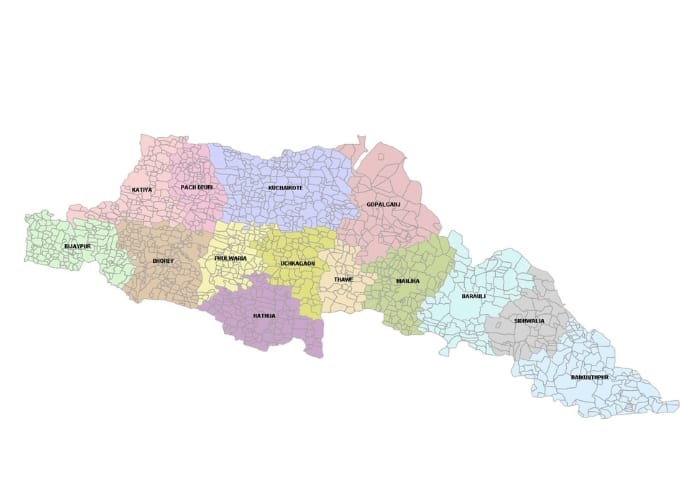Municipalities Gopalganj, Bihar
Gopalganj, located in the Indian state of Bihar, is a town of significant administrative and cultural importance. Serving as the headquarters of the Gopalganj district, it operates under a structured municipal framework that ensures the provision of essential services and infrastructure to its residents. This article delves into the municipalities within Gopalganj, their roles, recent developmental initiatives, and the overall impact on the community.


Municipal Structure of Gopalganj
Before achieving the status of an independent district, Gopalganj was a part of the historical Saran district, which was one of the oldest administrative divisions in Bihar. Saran district had extensive jurisdiction, encompassing several towns and subdivisions, including present-day Gopalganj. However, due to administrative and governance requirements, a decision was made to carve out Gopalganj as a separate district, ensuring better management and development of the region. On October 2, 1973, this vision was realized, and Gopalganj officially came into existence as an independent district. Since then, the district has celebrated October 2nd as its foundation day, commemorating its transition into a distinct administrative unit.
Administrative Structure and Headquarters
The municipal administration in Gopalganj is categorized into Nagar Panchayats and a Nagar Parishad, each responsible for governance and development within their respective jurisdictions.
Nagar Panchayat Barauli:
This local governing body administers the town of Barauli, focusing on urban planning, sanitation, and public health services.
Phone: 9431818196
Email: barauli.ulb@gmail.comNagar Panchayat Kateya:
Kateya’s municipal affairs are managed by this Panchayat, which oversees infrastructure development and maintenance of public amenities.
Phone: 9431818196
Email: kateya.ulb@gmail.comNagar Panchayat Mirganj:
Serving the town of Mirganj, this body is tasked with implementing development projects and ensuring the welfare of its inhabitants.
Phone: Not available
Email: Not availableNagar Parishad Gopalganj:
As the principal municipal body, the Nagar Parishad governs the town of Gopalganj, addressing urban development, waste management, and other civic services.
Phone: 6391789374
Email: urbanexgopa@gmail.com
Please note that contact information can change over time. For the most accurate and up-to-date details, it’s advisable to visit the official Gopalganj district website or contact the district administration directly.
These municipalities are instrumental in executing government schemes, maintaining law and order, and facilitating community development. Their responsibilities encompass a broad spectrum, including education, healthcare, sanitation, and infrastructure enhancement.
Demographic Overview
According to the 2011 Census of India, Gopalganj town had a population of 67,339, with males numbering 34,603 and females 32,736. Children aged 0-6 years constituted approximately 14.88% of the population. The literacy rate stood at an impressive 80.66%, surpassing the state average of 61.80%. Male literacy was recorded at 86.92%, while female literacy was at 74.07%. The town’s sex ratio was 946 females per 1,000 males, slightly above the state average of 918.
Recent Developmental Initiatives
In recent years, Gopalganj has witnessed several developmental projects aimed at improving infrastructure and public services.
Drainage Projects: In January 2025, the Gopalganj Municipality announced plans for 71 drainage projects to enhance the city’s infrastructure. These projects, with an estimated expenditure of ₹4.5 crore, aim to address issues of waterlogging and sanitation in various wards. However, the allocation of projects has sparked some controversy due to the disproportionate selection of certain wards.
Panchayat Government Buildings: In October 2024, Bihar’s Chief Minister Nitish Kumar inaugurated the construction of 59 Panchayat Government Buildings in Gopalganj via video conferencing. These modern structures are designed to house offices for public representatives and officials, facilitating efficient governance and public service delivery at the grassroots level.
Public Utilities and Services
The municipalities in Gopalganj are responsible for providing a range of public utilities and services, ensuring the well-being of residents.
Educational Institutions: Gopalganj hosts several educational establishments, including Gopeshwar College in Hathua, Kamla Rai College, and Mahendra Mahila College in Gopalganj town. These institutions contribute significantly to the educational development of the region.
Healthcare Facilities: The town is equipped with healthcare centers such as the Sadar Hospital in Gopalganj and the Sub-Divisional Hospital in Hathua, providing essential medical services to the populace.
Banking Services: Residents have access to various banking institutions, including Allahabad Bank, Bank of Baroda, Bank of India, Canara Bank, and Central Bank of India, facilitating financial transactions and services.
Postal Services: The Head Post Office located at Post Office Chowk in Gopalganj ensures postal and related services for the community.
Electricity Supply: The North Bihar Power Distribution Company Ltd. manages electricity distribution, striving to provide consistent power supply to the area.
Transportation Infrastructure
Gopalganj’s connectivity is bolstered by a network of roads and railways. National Highway 27 traverses the town, linking it to other significant regions. Additionally, the town is connected by rail, facilitating the movement of people and goods.
Future development plans for Gopalganj include further improvement of its transportation network, establishment of industrial hubs, and promotion of tourism. Given its historical and cultural significance, tourism could emerge as a potential sector for economic growth if properly developed and marketed.
Cultural and Social Landscape
The cultural fabric of Gopalganj is diverse, with Hinduism being the predominant religion, followed by Islam and smaller communities practicing Christianity, Sikhism, and Buddhism. This diversity is reflected in the town’s festivals, traditions, and communal harmony.
Future development plans for Gopalganj include further improvement of its transportation network, establishment of industrial hubs, and promotion of tourism. Given its historical and cultural significance, tourism could emerge as a potential sector for economic growth if properly developed and marketed.
Conclusion
The municipalities of Gopalganj play a pivotal role in the town’s administration and development. Through various initiatives and services, they strive to enhance the quality of life for residents. Continued focus on infrastructure development, public service delivery, and community engagement will be instrumental in

